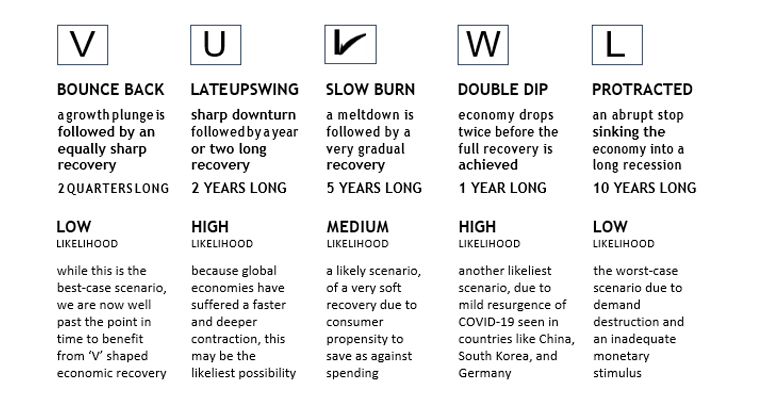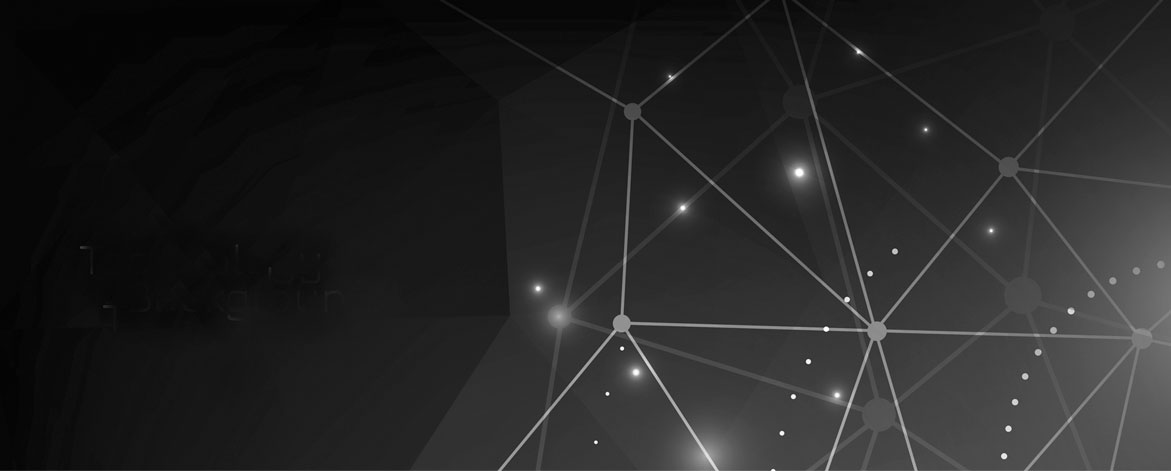Understanding the Geometry of Recession and Recovery
Deepak Prabhu, Vice President Consulting and Design Thinking writes about the geometry of recession and recovery and explores likely future scenarios as businesses prepare for the post lockdown period and an economic upswing.
AN UNPRECEDENTED GLOBAL CRISIS
Are we seeing the black swan of the black swans, one wonders? The expansion of the Novel Coronavirus (Covid-19) outbreak into a global pandemic since March 2020 has shifted the global economic outlook into a recession. The Covid-19 crisis has now impacted the entire globe with massive causalities.
While vaccines are showing early signs of success, the potential human impact of the disease is immense and a cause for global concern. No individual is today spared from this international emergency and its consequences. Besides this human impact, the coronavirus also has the potential to trigger an economic crisis. There is not a business that hasn’t been affected by the novel coronavirus and the subsequent lockdown.
We, the globalized economy, are today collectively facing, what is likely going to be the worst recessions ever. We have done worse than the 2007/08 financial crisis, but experts expect us to do much better than the great depression of the 1930s, when the US GDP declined 26%, peak to trough, and lasted 43 long months.
REOPENING TO BE A MASSIVE EXPERIMENT
We are going through unprecedented times in human history. We never had to shut down our economies like we did, in a jiffy, and having to reopen it in the setting of an ongoing pandemic. What seemed to work at a point in time yesterday has become questionable today, leaving us with no templates to follow. China, South Korea, Hong Kong and Singapore, the first off, the blocks, are facing fresh challenges as they reopen, and a looming threat of a relapse. The other nations have grouped their provinces into zones, guided by a loose correlation between disease prevalence and plans for reopening, those with more cases plan to reopen later.
Across the globe, businesses are experiencing differing impacts from the Covid-19 crisis and are responding with varying approaches. We should not expect any dependable pattern or a template to emerge as our contexts and operating conditions will be very different from each other.
Leaders should be prepared to incorporate new information and alter their approaches, either incrementally or radically, as new information becomes available. We should be willing to experiment and learn on the go.
Consider the case of Tesla, when Elon Musk defied the orders and kept the Fremont plant in California functioning in March, before local officials declared Tesla’s vehicle production was not essential and must come to a halt. In early May, Elon Musk sued the county and restarted operation around 12th of May against orders, daring officials to arrest him and eventually winning the support of President Trump. But by the second week of June, over half a dozen workers have tested positive. While Elon Musk garnered praise for voicing his opinion and walking the talk, emboldening other businesses to restart their operations, the emerging consequences risk being a spanner in the wheels
Says LC Singh, Vice Chairman at Nihilent, “Businesses are being given a crash course on making strategic decisions in real-time. Encouraging leaders to take a conservative approach. We should not be overly simplistic, for the arc of disaster is going to be long.”
He reflects on how we have been forced to confront new constraints, new perspectives and new realities, and advises businesses to embrace the situation as a part of life and quickly learn to adapt to the new normal.
UNWELCOME SEQUEL TO GREAT DEPRESSION
From an economic perspective, this crisis stands to go down in history as an unwelcome sequel to the great depression. This is a truly global crisis as no country is spared. Analysts expect to see a negative impact on all sectors of the economy, from bottlenecks in logistics and plant shutdowns to downturns in business investments and consumer spending. As things stand, we have beaten every conceivable number produced by the great recession of 2007-08. Luckily, no expert is betting on beating the great depression when the global economy went backwards for four consecutive years.
But even the worst of times won’t last forever, and economists are now weighing in on how an economic recovery will look. Given that the pandemic’s progress remains uncertain, weat Nihilent, we are continually assessing the impact and recovery in terms of scenarios. We outline 5 probable scenarios for how the situation may develop and recover from the Covid-19 induced global slowdown.

Given the state of lockdowns around the globe, experts have moved on from the best-case scenario of a ‘V’ shaped ‘bounce back’ economic recovery.
A ‘U’ shaped ‘late upswing’ recovery is the current front runner, which
indicates that the recovery may well run into 2021, however, promises us an upswing after all. With cases of a relapse emerging from economies which have relaxed containment measures prematurely, the double-dip, a ‘W’ shaped ‘double-dip’ recovery path is fast emerging as a possibility.
A variant of the ‘U’ model, the ‘√’ shaped ‘slow burn’ recovery is characterized by economic outputs which stay beneath the level of its pre-crisis trend well into 2021, as a result of spending weighed down by debts. The ‘L’ shaped ‘protracted’ recovery is the worst-case scenario, whereby the economy sinks and then stays on the ocean floor for a prolonged period, often decade long. Fortunately, the ‘√’ shaped and the ‘L’ shaped recovery models, at this point, looks only a distant possibility.
There is no dearth of alphabets to describe potential recovery paths. A ‘Z’ shaped recovery is when spending surges are so fierce that growth is lifted above the trendline and then after a party settles down to trend. Then there is an inverted- square-root-shape popularised by George Soros, whereby the economy hits bottom and automatically rebound some, but then it doesn’t come out of it in a V-shape recovery or anything like that but settles down at lower levels. The ‘J’ model is, allegedly only for the optimists, whereby the economy rebounds far beyond pre-recession levels. Then, there are also the contrarians who do not subscribe to any alphabet at all.
“Only time can throw light on the future,” says Minoo Dastur, CEO at Nihilent. As the crises prolong, Minoo believes that unemployment will continue to rise, and both demand and consumption across sectors will decline. He points us to the IMF projection made few months back, of a 3% contraction of the global GDP. Only a handful of economies, such as China and India, are expected to grow in 2020, IMF said. The ‘Great Lockdown’ is projected to slice $9 trillion off of global growth, greater than the economies of Japan and Germany combined, over the next 20 months. “With every passing week, the projected numbers, unfortunately, look increasingly optimistic” he concludes.
GOVERNMENT STIMULUS TO SET PACE FOR RECOVERY
After the lockdown ends, the economy will emerge out of the crisis on the back of the opportunities arising out of the emerging trends, such as work from home, manufacturing activities redistributing across the emerging economies, a breakthrough in healthcare and medical sectors, and a new lease of life for consumer and financial services. While the general consensus hints at a ‘U’ shaped recovery for the economy as a whole, with ‘W’ slowly coming into the reckoning, we believe that different industries will have their paths to recovery. This will be shaped by the real impact of the novel coronavirus on demand and supply on one hand, and the kind of stimulus packages they get to benefit from the governments of the day.
As we look around, we see many encouraging signs, but countries are taking a divergent approach from one another. Across the world, country stimulus responses vary from 1 per cent of GDP to 15 per cent of GDP as of now. Rich countries seem to have announced larger stimulus packages (8 to 12 per cent) and poor countries have announced smaller packages (2 to 7 per cent). Germany and Italy’s economic assistance is pegged at over 30% of the GDP. A leading consulting company estimates the total global package at $ 10 trillion at the time of writing this article, and no one should be surprised if the number grows, as many countries continue to announce additional packages.
The Chinese Premier Li Keqiang broke with tradition in abandoning a formal GDP target for 2020. Unlike the US or Japan, which announced stimulus packages worth $2 trillion, China’s response on this front has been rather muted, at just 3% of its GDP, relying instead on administrative measures like government tax and fee cuts and pressure on landlords to forgive rents and companies to limit layoffs. However, Mr Li’s efforts in encouraging entrepreneurialism at the micro-scale have received global attention, with a shift from its decade long policy of clamping down on street vendors in the name of food safety and hygiene, to now working hard to fill the streets again with hawker stalls, food trucks and other kinds of sidewalk retailers. “The country will get better if the market, enterprises and individual business owners survive and develop. We will support you,” he said while hailing street-side food stalls’ contributions to “human culinary culture.”
The Indian government too has taken some very bold steps. Prime Minister Modi announced ₹ 20 Lakh Crores worth of stimulus package and outlined the focus areas as land, labour, liquidity and laws. To put things in perspective, the relief package is the 5th largest among the G20 economies, amount to 10% of India’s GDP. While women with Jan Dhan accounts will receive ₹ 500, the senior citizens, poor widows and the disabled will receive ₹ 1000. The government also announced a hike in the payment of MGNREGA, its marquee rural employment scheme.
And importantly, the government announced, for the micro, small and medium enterprises (MSME), many measures to measures to help easy access to credit and equity infusion, including collateral-free loan scheme, loans for critical MSMEs and mega ‘fund of funds’ to provide liquidity. We do expect periodic assessments and corrective actions in terms of focused assistance to the sectors which need them.
We have come far away from the era of the industrial revolution. We are living in times where businesses operate at the speed of thought. Besides, we do not doubt that the indomitable human spirit will bounce back from the clutches of the great lock down with vengeance. It is only a matter of time.
Can the world economies avoid a double-dip pattern of recovery?

Deepak partners with clients from around the world to uncover emerging customer and market dynamics, frame and reframe business challenges, open unchartered spaces and start conversations around the new possibilities. He passionately seeks to leverage design’s transformative capacity to tackle the biggest of the challenges, both business and social.





